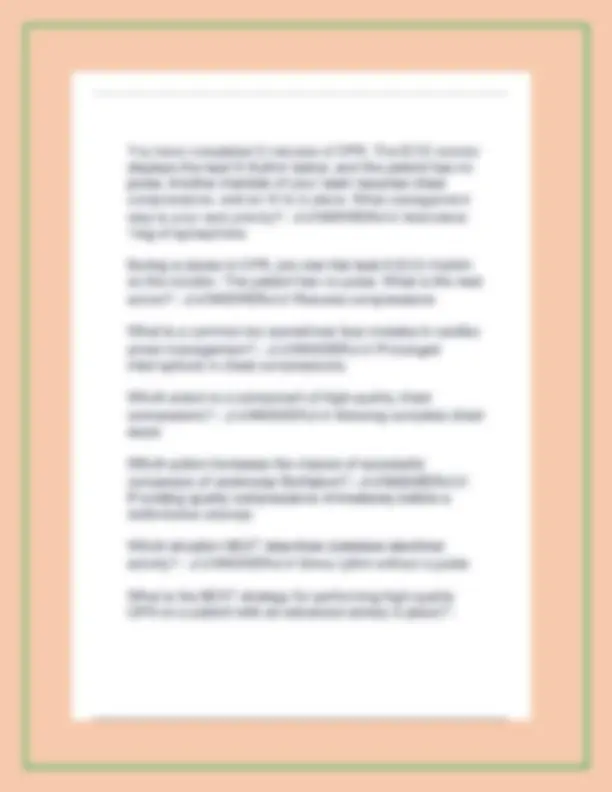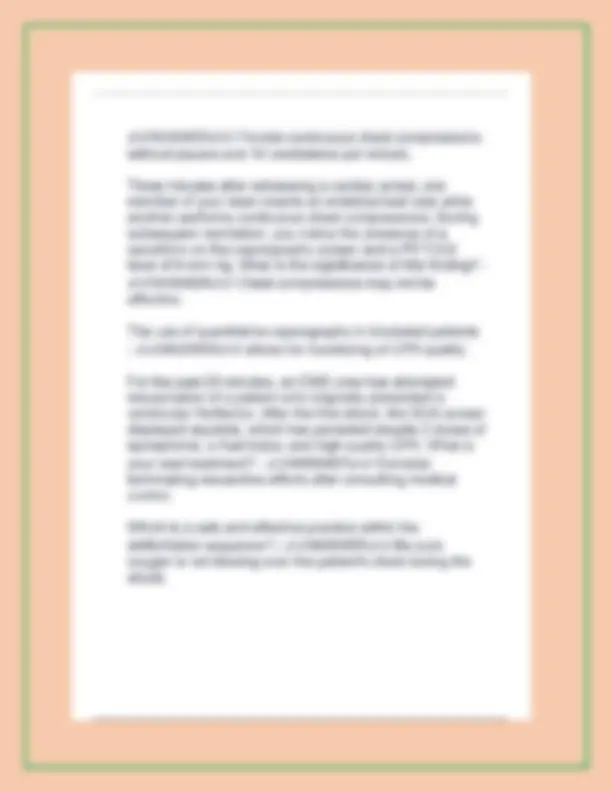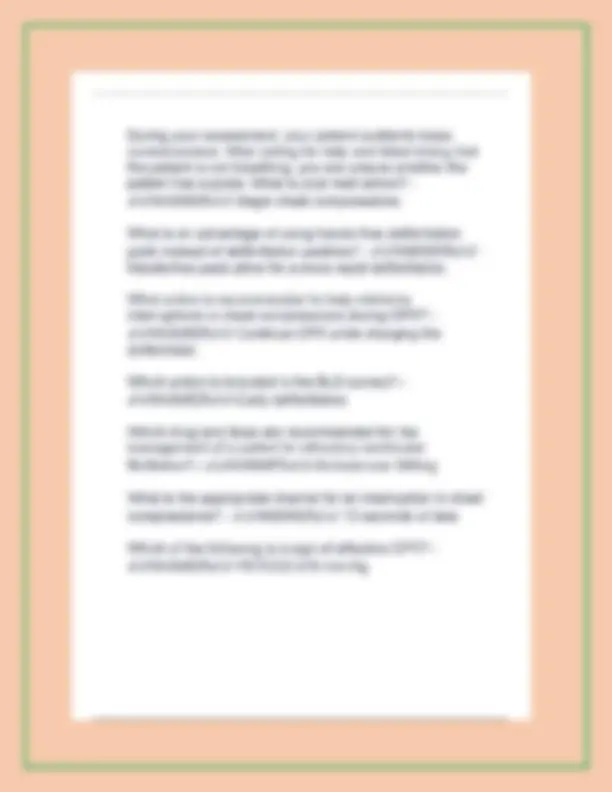





































































Study with the several resources on Docsity

Earn points by helping other students or get them with a premium plan


Prepare for your exams
Study with the several resources on Docsity

Earn points to download
Earn points by helping other students or get them with a premium plan
Community
Ask the community for help and clear up your study doubts
Discover the best universities in your country according to Docsity users
Free resources
Download our free guides on studying techniques, anxiety management strategies, and thesis advice from Docsity tutors
ACLS INSTRUCTOR EXAM TEST BANK 2025 | COMPLETE VERIFIED QUESTIONS AND DETAILED CORRECT ANSWERS | GRADED A+ | LATEST AMERICAN HEART ASSOCIATION (AHA) ACLS INSTRUCTOR STUDY GUIDE
Typology: Exams
1 / 75

This page cannot be seen from the preview
Don't miss anything!




































































elect the correct --CORRECT ANSWER -- to this question. 10 to 15 mmHg 20 to 25 mmHg 25 to 30 mmHg 35 to 45 mmHg - --CORRECT ANSWER -- - 35 to 45 mmHg A patient's ECG reveals a tachyarrhythmia. The patient is hemodynamically stable and has a heart rate ranging from 120 to 135 beats per minute. Based on the findings of the secondary assessment, which statement(s) by the patient would the team interpret as a possible contributing cause? Select all correct options that apply. "I've had a terrible cold with a horrible cough and fever the past week." "I've been so anxious lately because I just lost my job." "I had an aortic valve replacement several years ago." "I've had a history of heart disease for the past 3 years." "I've been vomiting for the past 2 days from a gastrointestinal bug." - --CORRECT ANSWER -- - "I've had a terrible cold with a horrible cough and fever the past week." "I've been so anxious lately because I just lost my job." "I've been vomiting for the past 2 days from a gastrointestinal bug." A patient presents to the emergency department with suspected ACS. Electrocardiogram and cardiac biomarkers show the patient has ST-segment elevation myocardial infarction (STEMI). Physical examination reveals signs of left ventricular dysfunction. Which finding(s) would support this?
Select all correct options that apply. Weak peripheral pulses Chest pain Cool, clammy skin Crackles Hypotension - --CORRECT ANSWER -- - Weak peripheral pulses Hypotension Crackles A 20-year-old man with respiratory depression is brought to the emergency department by his parents. The parents state that "[They] found him at home with various needles and syringes around him, but [they] have no idea what he took." Opioid overdose is suspected, and an initial dose of naloxone is administered at 10 p.m. The patient does not respond to this initial dose. The team would expect to administer a second dose after how many minutes? Select the correct --CORRECT ANSWER -- to this question. 2 minutes 4 minutes 6 minutes 8 minutes - --CORRECT ANSWER -- - 4 minutes A person suddenly collapses while sitting in the sunroom of a healthcare facility. A healthcare provider observes the event and hurries over to assess the situation. The healthcare provider performs which assessment first? Select the correct --CORRECT ANSWER -- to this question. Rapid assessment
0.10 mV 0.15 mV 0.2 mV 0.25 mV - --CORRECT ANSWER -- - 0.15 mV A patient presents to the emergency department with mild to moderate recurrent chest pain, without any nausea or vomiting. A 12-lead ECG is obtained and shows ST-segment depression with transient T-wave elevation indicative of NSTE-ACS. Cardiac serum markers are obtained and are not elevated. The patient's risk-stratification score indicates low risk. These findings suggest which condition? Select the correct --CORRECT ANSWER -- to this question. Non-STEMI Myocardial infarction STEMI Unstable angina - --CORRECT ANSWER -- - Unstable angina The following capnogram is from a patient experiencing respiratory distress. At which point in the waveform would the patient's ETCO2 level be measured? - --CORRECT ANSWER -- - D A patient's capnogram reveals the following waveform. Which segment would the healthcare provider interpret as reflecting the beginning of exhalation? - --CORRECT ANSWER -- - A-B Cardiac monitoring of a patient in cardiac arrest reveals ventricular fibrillation. What intervention would the team perform next? Initiate capnography. Administer 1 shock.
Provide post-cardiac arrest care. Insert an advanced airway. - --CORRECT ANSWER -- - Administer 1 shock A patient comes to the emergency department with a suspected stroke. The patient is alert and oriented and accompanied by a family member. The family member says, "I noticed he was slurring his words and had trouble walking, like his leg was numb." Which finding would suggest that the patient is experiencing a condition that mimics a stroke? Hyperkalemia Hypoglycemia Hyperglycemia Hypokalemia - --CORRECT ANSWER -- - Hypoglycemia A patient experiences cardiac arrest, and the resuscitation team initiates ventilations using a bag-valve-mask (BVM) resuscitator. The development of which condition during the provision of care would lead the team to suspect that improper BVM technique is being used? Hypertension Esophageal injury Pneumothorax Rib fracture - --CORRECT ANSWER -- - Pneumothorax Complications can occur with the use of a BVM resuscitator due to improper technique. Delivering excessive volume or ventilating too fast creates excessive pressure that can damage the airways, lungs and other organs. Excessive volume can lead to tension pneumothorax. A person suddenly collapses while sitting in the sunroom of a healthcare facility. A healthcare provider observes the event and hurries over to assess the situation. The healthcare provider performs which assessment first?
"We initiated chest compressions at a rate of 100 to 110 per minute to a depth of 2.4 inches and then gave 1 ventilation every 10 seconds." "We provided chest compressions at a rate of 100 to 120 compressions per minute while giving 1 ventilation every 6 seconds without pausing compressions." "We provided chest compressions at a rate of 80 to 120 per minute to a depth of at least 2 inches and gave 1 ventilation every 6 seconds without pausing compressions." "We kept the rate of chest compressions to around 100 per minute but adjusted their depth to 1.5 inches while giving 1 ventilation every 3 seconds without pausing compression - --CORRECT ANSWER -- - "We provided chest compressions at a rate of 100 to 120 compressions per minute while giving 1 ventilation every 6 seconds without pausing compressions." When an advanced airway has been placed in a patient who is in cardiac arrest, compressions should be delivered continuously (100 to 120 per minute) with no pauses for ventilations. Assessment of a patient reveals an ETCO2 level of 55 mmHg and an arterial oxygen saturation (SaO2) level of 88%. The provider would interpret these findings as indicative of which condition? Respiratory failure Respiratory arrest Cardiac arrest Respiratory distress - --CORRECT ANSWER -- - Respiratory failure An SaO2 level of less than 90% (PaO2 of less than 50 mmHg) accompanied by ETCO2 values greater than 50 mmHg is indicative of respiratory failure. A responsive patient is choking. What method should the provider use first to clear the obstructed airway?
Back blows Abdominal thrusts Magill forceps extraction Chest compressions - --CORRECT ANSWER -- - Back blows To clear an obstructed airway in a responsive adult, first provide up to 5 back blows to clear the obstruction. A patient arrives at the emergency department complaining of shortness of breath. The patient has a long history of chronic obstructive pulmonary disease. Assessment reveals respiratory failure. Which action would be the initial priority to address the respiratory failure? Establishment of vascular access Delivery of supplemental oxygen via nasal cannula Assisted ventilation with BVM resuscitator Initiation of capnography - --CORRECT ANSWER -- - Assisted ventilation with BVM resuscitator Patients who cannot ventilate adequately despite an open airway or who have insufficient respiratory effort require assisted ventilation initially provided via a BVM resuscitator. A 20-year-old man with respiratory depression is brought to the emergency department by his parents. Opioid overdose is suspected, and an initial dose of naloxone is administered at 10 p.m. The patient does not respond to this initial dose. The team would expect to administer a second dose after how many minutes? 2 minutes 4 minutes 6 minutes
A patient is experiencing respiratory distress secondary to an exacerbation of chronic obstructive pulmonary disease. The patient begins to exhibit signs and symptoms of worsening respiratory function and experiences respiratory arrest. The team intervenes, delivering ventilations via BVM resuscitator. The team should provide ventilations at a rate of 1 ventilation: Every 3 seconds Every 6 seconds Every 8 seconds Every 10 seconds - --CORRECT ANSWER -- - Every 6 seconds The team would deliver 1 ventilation every 6 seconds. Each ventilation should last about 1 second and make the chest begin to rise. A patient enters the emergency department in respiratory compromise. The team is monitoring the patient using capnography and identifies that ETCO2 levels are initially 33 mmHg and later 40 mmHg. From these readings, the team identifies that the patient is progressing in what stage of respiratory compromise? Respiratory arrest Respiratory failure Respiratory distress Respiratory acidosis - --CORRECT ANSWER -- - Respiratory distress Capnography can objectively assess the severity of a patient's respiratory distress. Early on, the patient will often hyperventilate, leading to hypocapnia that is reflected by a low ETCO2 value (less than 35 mmHg). As respiratory distress increases, and the patient begins to tire, the ETCO value may return to the normal range (35 to 45 mmHg). However, if the patient progresses to respiratory failure, the ETCO2 level will increase to greater than 45 mmHg, which indicates hypoventilation.
A patient is in cardiac arrest. The underlying cause is thought to be opioid toxicity. Which statement accurately describes the use of naloxone for this patient? Naloxone should be administered immediately as the first action in resuscitation at a dose of 0. to 2 mg and then repeated every 2 to 3 min as needed. Naloxone has not been shown to be effective for opioid toxicity once cardiac arrest has occurred. Naloxone administered via continuous IV infusion should be considered for short-acting opioid toxicity. Naloxone should be administered as soon as possible but is not a priority over high-quality CPR and AED use. - --CORRECT ANSWER -- - Naloxone should be administered as soon as possible but is not a priority over high-quality CPR and AED use. High-quality CPR and AED use are the priority interventions for cardiac arrest caused by suspected or known opioid toxicity. When opioid toxicity is the suspected or known cause of cardiac arrest, naloxone should be administered as soon as possible without disrupting or delaying high-quality CPR and AED use. The recommended dose of naloxone is 0.4 to 2 mg IV/IO/IM/IN/SC, repeated every 2 to 3 minutes as needed. A continuous naloxone infusion may be considered if there is the potential for recurrence of respiratory depression (for example, if the cause of the opioid toxicity was an extended-release or long-acting opioid) but is not indicated in the immediate treatment of suspected or known opioid toxicity A patient in the telemetry unit is receiving continuous cardiac monitoring. The patient has a history of myocardial infarction. The patient's ECG rhythm strip is shown in the following figure. The provider interprets this strip as indicating which arrhythmia? Sinus tachycardia Third-degree AV block
Atrial fibrillation Atrial flutter Ventricular fibrillation Ventricular tachycardia - --CORRECT ANSWER -- - Atrial flutter In atrial flutter, atrial contraction occurs at such a rapid rate that discrete P waves separated by a flat baseline cannot be seen on the strip. Instead, the baseline continually rises and falls, producing the "flutter" waves. In leads II and III, the flutter waves may be quite prominent, creating a "sawtooth" pattern. Because of the volume of atrial impulses, the AV node allows only some of the impulses to pass through to the ventricles. In atrial flutter, a 2:1 ratio is the most common (i.e., for every two flutter waves, only one impulse passes through the AV node to generate a QRS complex). Ratios of 3:1 and 4:1 are also frequently seen. The ECG rhythm strip of a patient who arrived in the emergency department complaining of dizziness, syncope and shortness of breath reveals sinus bradycardia. When reviewing the patient's medication history, the healthcare provider identifies which agent(s) as a potential cause of the patient's current condition? Digoxin Losartan Metoprolol Verapamil Quinapril - --CORRECT ANSWER -- - igoxin
Metoprolol Verapamil Medications associated with causing sinus bradycardia include β-blockers (such as metoprolol), calcium channel blockers (such as verapamil) and digoxin. A patient with bradycardia and signs of hemodynamic compromise does not respond to atropine. Which interventions could the healthcare provider use next? Transcutaneous pacing Carotid massage Epinephrine or dopamine infusion Synchronized cardioversion - --CORRECT ANSWER -- - Transcutaneous pacing Epinephrine or dopamine infusion Second-line therapies for symptomatic bradycardia include transcutaneous pacing or an epinephrine or dopamine infusion. A patient's ECG reveals a narrow QRS complex with a regular rhythm, indicating a narrow- complex supraventricular tachyarrhythmia. The patient is not showing signs of hemodynamic compromise. Which intervention would be initiated first if it does not delay other interventions? Synchronized cardioversion